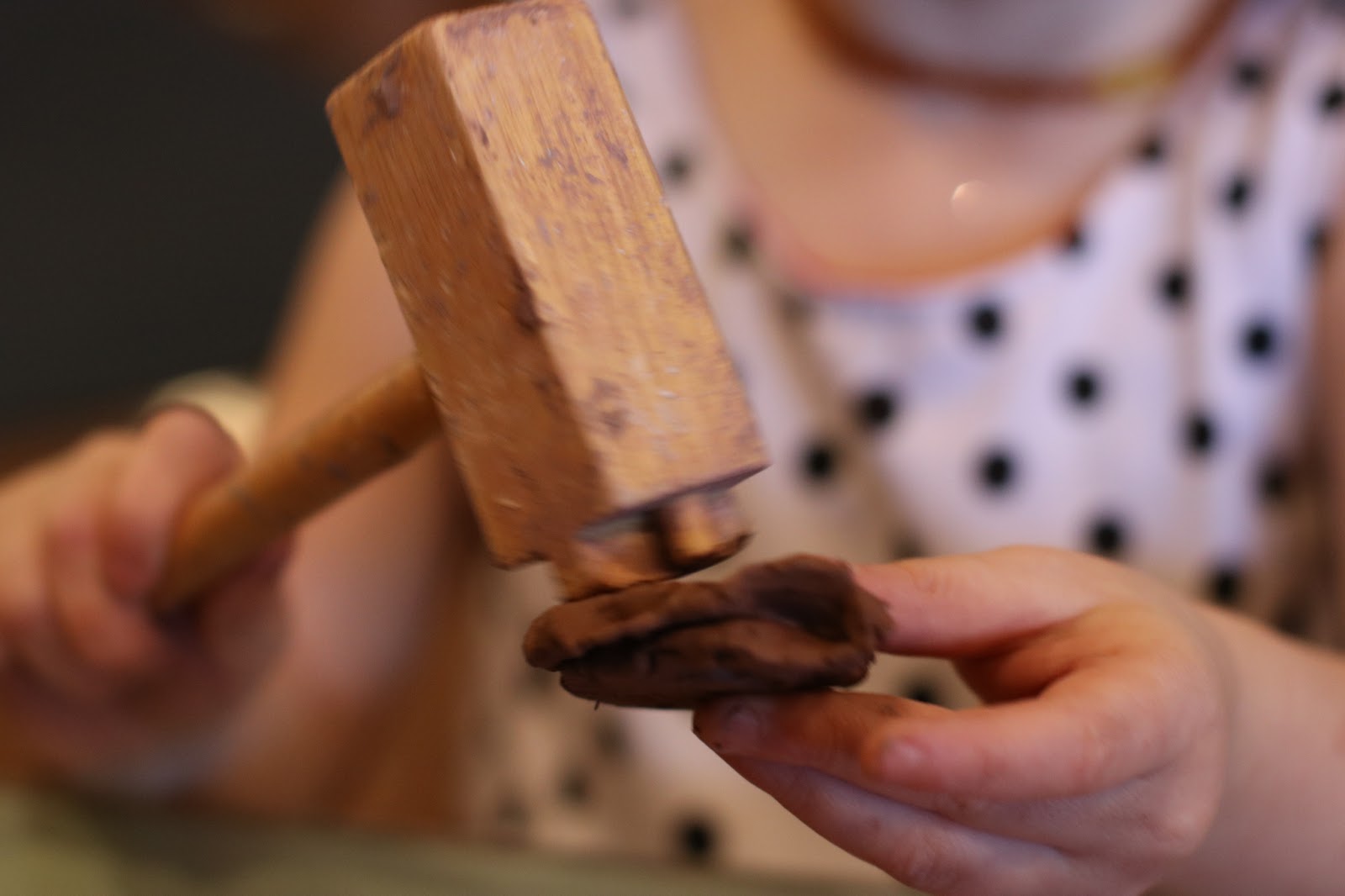I think many times when it comes to material introduction, we jump to the “create and make stage” yet forget the explore stage. Yes! The magic and wonder of the explore stage is crucial!

The language of clay! It’s different from playdough. Clay comes from the earth. The cold, messy, earthy aroma activates all the senses.You can manipulate it by adding water and return to a creation day after day by having the child cover their piece with a wet paper towel.

What are you making? That seems to be a consistent first question we always ask. But, what if we kept the wonder alive in our children and think about the relationship with clay or any other material?
Exploration Questions Starters
What do you notice about the clay?
I wonder how it feels?
How can you get it off the big block?
I wonder how we can stick the pieces together?
What happens when you add water?
Tell me about how it smells…feels…sounds…even tastes!
Explore Stages of Clay
1. Finger and Hand Play
Pinching, ball rolling, squeezing pieces are a few things this child manipulated clay with.
2. Rolling
Rolling pins, cans, wooden dowels, and cardboard tubes are a few examples to use for rolling.
3. Pounding
An avenue to use force!. Fabulous way to let the need be met.
4. Cutting
Fine motor skills being executed here. Way to build those muscles for writing.
5. Addition of Loose Parts
A simple jam jar lid can provide a vast extension to the explore stage in clay
6. Piling
The simple task of piling turns into building tall and problem solving to make it stay.
Benefits of Exploring Clay
- Gives children the sensory experiences they so desperately need
- Develops their fine motor skills
- Opportunities for Storytelling
- Builds child’s ability to focus
- Ignites the children’s curious and creative nature
- Allows for a natural progression in their developmental stages with materials
And so much more!
Let’s foster the explore stage with materials in our classrooms! Let them linger and wonder a bit longer. Stay tuned for the explore stages with paint and glue in upcoming blog posts!
Comment below how you use clay in your room! We would love to see photos!











We have just started to experiment with air dry clay . We use Amaco Stonex Clay because it seems the most like regular clay in texture, feel, and smell. You can even make slip with it! I do not have access to a kiln so I stick with air dry for most things… We have been having such fun. The kids in my classes range in ages from 2-11 depending on the class and they all love it!
Oh, Jennifer! Thanks for the tip!
I love using just hands to explore clay with Infants and Toddlers! There are so many ways to present the clay, without even involving tools, and they really get to get familiar with how each action affects the clay. We vary it by offering different sizes of cubes, balls, cylinders, or large slabs (great for scraping with fingers!), as well as trying out different levels of firmness (soft is great for pinching and changing shapes, but firmer encourages a lot of scraping and gouging).
I am a storyteller and I love having children play to make their stories come to life. They become storymakers. I was just thinking how clay would be a great loose part to use with stories
I had to share this on Fingerprints To Masterpieces page. Love it!
Hello! Any tips for which clay is best to buy for toddlers? Ideally as non-toxic as possible please 🙂
I recommend REAL potter’s clay that you would buy from an art supply store. Real clay is a natural material with no artificial additives. The way you will know it is the real deal is that it is sold in 10 pound bags. Here’s a great article on it: https://www.bartelart.com/arted/Clay&Toddlers.html
Dear Sally,
Your blog is so inspiring! Thank you so much for sharing your insights with all of us, you truly make a difference!
What type of clay do you use?
Hi Tia, sorry for the delay in responding. You can use real potters clay. You can get it in red or gray and can usually be purchased Blick Art Supplies online or Amazon. Thanks for the great question!
We love your clay stages and it has really helped us develop clay as part of our provision. Have you posted stages of paint yet?
I love the idea of using clay. It can be so fun for kids to feel and definitely explore different ways of molding it!
I once collected fallen leaves from sycamore and magnolia trees in a park with a group of five-year-olds. There was a discussion around the smell, shape, and veins of the leaves. Then we returned to the classroom to make leaf door signs. Some children chose to roll out different shapes in clay and then put them together to become a leaf. Some children used tools to cut out shapes and patterns. Still, other children used fallen leaves to press out patterns on the clay. After reading your ideas, I realized that I should have provided opportunities for the children to explore the clay first.